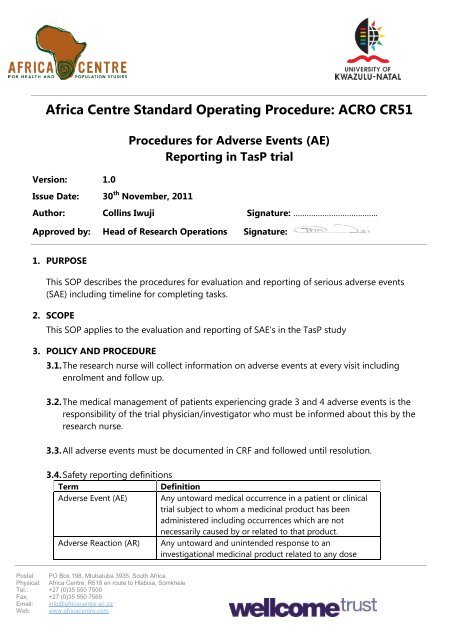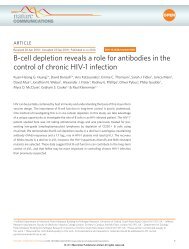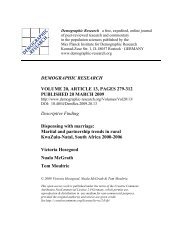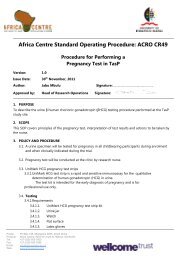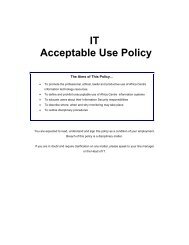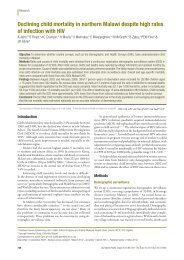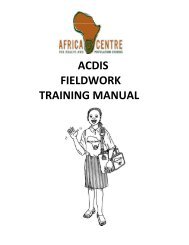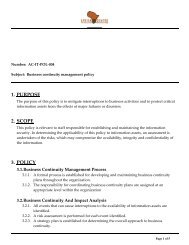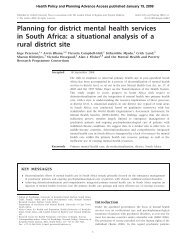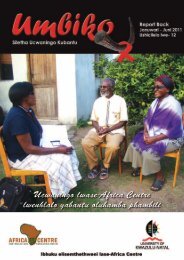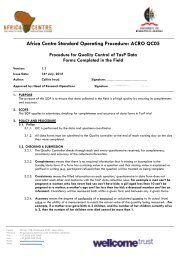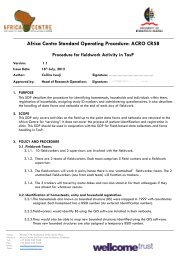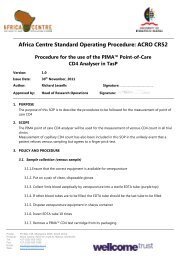Procedure for Adverse Events (AE) reporting in TasP Trial
Procedure for Adverse Events (AE) reporting in TasP Trial
Procedure for Adverse Events (AE) reporting in TasP Trial
You also want an ePaper? Increase the reach of your titles
YUMPU automatically turns print PDFs into web optimized ePapers that Google loves.
Africa Centre Standard Operat<strong>in</strong>g <strong>Procedure</strong>: ACRO CR51<br />
Version: 1.0<br />
Issue Date: 30 th November, 2011<br />
<strong>Procedure</strong>s <strong>for</strong> <strong>Adverse</strong> <strong>Events</strong> (<strong>AE</strong>)<br />
Report<strong>in</strong>g <strong>in</strong> <strong>TasP</strong> trial<br />
Author: Coll<strong>in</strong>s Iwuji Signature: ………………………………..<br />
Approved by: Head of Research Operations Signature:<br />
1. PURPOSE<br />
This SOP describes the procedures <strong>for</strong> evaluation and <strong>report<strong>in</strong>g</strong> of serious adverse events<br />
(S<strong>AE</strong>) <strong>in</strong>clud<strong>in</strong>g timel<strong>in</strong>e <strong>for</strong> complet<strong>in</strong>g tasks.<br />
2. SCOPE<br />
This SOP applies to the evaluation and <strong>report<strong>in</strong>g</strong> of S<strong>AE</strong>’s <strong>in</strong> the <strong>TasP</strong> study<br />
3. POLICY AND PROCEDURE<br />
3.1. The research nurse will collect <strong>in</strong><strong>for</strong>mation on adverse events at every visit <strong>in</strong>clud<strong>in</strong>g<br />
enrolment and follow up.<br />
3.2. The medical management of patients experienc<strong>in</strong>g grade 3 and 4 adverse events is the<br />
responsibility of the trial physician/<strong>in</strong>vestigator who must be <strong>in</strong><strong>for</strong>med about this by the<br />
research nurse.<br />
3.3. All adverse events must be documented <strong>in</strong> CRF and followed until resolution.<br />
3.4. Safety <strong>report<strong>in</strong>g</strong> def<strong>in</strong>itions<br />
Term<br />
Def<strong>in</strong>ition<br />
<strong>Adverse</strong> Event (<strong>AE</strong>) Any untoward medical occurrence <strong>in</strong> a patient or cl<strong>in</strong>ical<br />
trial subject to whom a medic<strong>in</strong>al product has been<br />
adm<strong>in</strong>istered <strong>in</strong>clud<strong>in</strong>g occurrences which are not<br />
necessarily caused by or related to that product.<br />
<strong>Adverse</strong> Reaction (AR) Any untoward and un<strong>in</strong>tended response to an<br />
<strong>in</strong>vestigational medic<strong>in</strong>al product related to any dose<br />
Postal: PO Box 198, Mtubatuba 3935, South Africa<br />
Physical: Africa Centre, R618 en route to Hlabisa, Somkhele<br />
Tel.: +27 (0)35 550 7500<br />
Fax: +27 (0)35 550 7565<br />
Email: <strong>in</strong>fo@africacentre.ac.za<br />
Web: www.africacentre.com
Africa Centre Standard Operat<strong>in</strong>g <strong>Procedure</strong>: ACRO CR51<br />
<strong>Adverse</strong> Event (<strong>AE</strong>) Report<strong>in</strong>g <strong>in</strong> <strong>TasP</strong> <strong>Trial</strong><br />
Unexpected <strong>Adverse</strong><br />
Reaction (UAR<br />
Serious <strong>Adverse</strong> Event<br />
(S<strong>AE</strong>) or Serious <strong>Adverse</strong><br />
Reaction (SAR) or<br />
Suspected Unexpected<br />
Serious <strong>Adverse</strong> Reaction<br />
(SUSAR)<br />
adm<strong>in</strong>istered<br />
An adverse reaction, the nature or severity of which is not<br />
consistent with the <strong>in</strong><strong>for</strong>mation about the medic<strong>in</strong>al<br />
product <strong>in</strong> question set out <strong>in</strong> the Summary of Product<br />
Characteristics (or Investigator Brochure) <strong>for</strong> that product.<br />
Respectively any adverse event, adverse reaction or<br />
unexpected adverse reaction that:<br />
results <strong>in</strong> death<br />
is life-threaten<strong>in</strong>g*<br />
requires hospitalisation or prolongation of exist<strong>in</strong>g<br />
hospitalisation**<br />
results <strong>in</strong> persistent or significant disability or<br />
<strong>in</strong>capacity<br />
consists of a congenital anomaly or birth defect<br />
requires medical <strong>in</strong>tervention <strong>in</strong>tended to prevent<br />
one of the outcomes listed above <strong>in</strong> the def<strong>in</strong>ition<br />
of S<strong>AE</strong><br />
is estimated by the <strong>in</strong>vestigator as potentially<br />
serious<br />
3.4.1. Clarifications<br />
3.4.1.1. The term ‘life-threaten<strong>in</strong>g’<strong>in</strong> the def<strong>in</strong>ition of serious’refers to an event <strong>in</strong><br />
which the patient was at risk of death at the time of the event; it does not refer<br />
to an event which hypothetically might have caused death if it were more<br />
severe.<br />
3.4.1.2. Hospitalisation is def<strong>in</strong>ed as an <strong>in</strong>patient admission, regardless of length of stay,<br />
even if the hospitalisation is a precautionary measure <strong>for</strong> cont<strong>in</strong>ued observation.<br />
Hospitalisations <strong>for</strong> a pre-exist<strong>in</strong>g condition (<strong>in</strong>clud<strong>in</strong>g elective procedures that<br />
have not worsened) do not constitute an S<strong>AE</strong>.<br />
3.4.2. With<strong>in</strong> the frame of this trial S<strong>AE</strong> also <strong>in</strong>cludes<br />
3.4.2.1. Grade 4 cl<strong>in</strong>ical and biological events<br />
3.4.2.2. Acute renal failure or Fanconi’s syndrome<br />
3.5. Characterisation of an adverse event<br />
3.5.1. Severity<br />
3.5.1.1. Apart from its seriousness, adverse events are also described based on its<br />
severity; which is established based on gradation tables of cl<strong>in</strong>ical and<br />
biological events (appendix 1). ANRS Serious Quotation Table <strong>for</strong> the<br />
adverse events <strong>in</strong> Adults—version no 6 dated 9 September 2003 <strong>in</strong> Frenchversion<br />
no 1 dated 4 November 2008 <strong>in</strong> English.<br />
Page 2 of 6
Africa Centre Standard Operat<strong>in</strong>g <strong>Procedure</strong>: ACRO CR51<br />
<strong>Adverse</strong> Event (<strong>AE</strong>) Report<strong>in</strong>g <strong>in</strong> <strong>TasP</strong> <strong>Trial</strong><br />
3.5.1.2. The severity of an adverse event is not synonymous with seriousness: severity<br />
refers to the <strong>in</strong>tensity of a given event while seriousness refers to the impact<br />
of an event on the vital or functional prognosis of a subject.<br />
3.5.2. Causality<br />
3.5.2.1. This assesses the relationship between the adverse event and the study<br />
drugs, associated drug(s) or with the conduct of the research itself.<br />
3.5.2.2. The study physician/<strong>in</strong>vestigator assesses the relationship between the<br />
event and the study and or associated drugs on the <strong>in</strong>itial and<br />
complementary notification <strong>for</strong>ms.<br />
3.5.2.3. The sponsor (pharmacovigilance team of ANRS) also determ<strong>in</strong>es the<br />
relationship between the event and the study and or associated drugs or the<br />
research. The op<strong>in</strong>ion of the sponsor is given by the pharmacovigilance team.<br />
3.5.2.4. The f<strong>in</strong>al causality of the events with respect to the study and or associated<br />
drugs or the research shall be either the causality established by the<br />
<strong>in</strong>vestigator or the sponsor’s. However the causal relationship given by the<br />
<strong>in</strong>vestigator shall not be modified: if the sponsor does not agree with the<br />
conclusions of the <strong>in</strong>vestigator, both divergent conclusions shall be<br />
mentioned <strong>in</strong> the report.<br />
3.5.3. ANRS causality assessment<br />
3.5.3.1. All adverse events are to be assessed <strong>for</strong> the relationship to the study drug by<br />
the trial physician based on the follow<strong>in</strong>g def<strong>in</strong>itions:<br />
3.5.3.1.1. Not related: The event is clearly related to other causes, such as the<br />
cl<strong>in</strong>ical event of the patient or a concomitant treatment without any<br />
pharmacological <strong>in</strong>teraction with the experimental drug.<br />
3.5.3.1.2. Possibly related: Cl<strong>in</strong>ical or biological event with a compatible<br />
chronological, aetiological and semilogical relation.<br />
3.5.3.1.3. Relationship impossible to determ<strong>in</strong>e: A potential causal relation<br />
between the experimental drugs and the event may exist; it may neither be<br />
affirmed nor excluded at the time of the declaration through a lack of<br />
cl<strong>in</strong>ical elements.<br />
Page 3 of 6
Africa Centre Standard Operat<strong>in</strong>g <strong>Procedure</strong>: ACRO CR51<br />
<strong>Adverse</strong> Event (<strong>AE</strong>) Report<strong>in</strong>g <strong>in</strong> <strong>TasP</strong> <strong>Trial</strong><br />
3.5.4. Expectedness<br />
3.5.4.1. The expectedness of an event is assessed by the trial physician and is based<br />
on <strong>in</strong><strong>for</strong>mation listed <strong>in</strong> the package <strong>in</strong>sert or summary of product<br />
characteristics.<br />
3.5.4.2. If a SAR is assessed as be<strong>in</strong>g unexpected it becomes a SUSAR<br />
3.5.5. S<strong>AE</strong> <strong>report<strong>in</strong>g</strong><br />
3.5.5.1. The S<strong>AE</strong> should be reported by the trial physician if they occur from the date of<br />
the <strong>in</strong><strong>for</strong>med consent signature <strong>for</strong> ART (even if no drugs were adm<strong>in</strong>istered).<br />
3.5.5.2. Dur<strong>in</strong>g the entire duration of the trial.<br />
3.5.5.3. Up to one month after the end of the trial if the event is suspected to be related<br />
to the trial.<br />
3.5.5.4. And any time after the completion of the trial if the event is suspected to be<br />
related to ART.<br />
3.5.6. S<strong>AE</strong> notification<br />
3.5.6.1. The trial coord<strong>in</strong>ator/HIV phsyician will notify each S<strong>AE</strong> to the trial <strong>in</strong>vestigator<br />
at the Africa Centre as soon as he is aware of the event.<br />
3.5.6.2. The trial coord<strong>in</strong>ator/HIV physician will complete the trial specific “Initial<br />
Serious <strong>Adverse</strong> Event Notification” <strong>for</strong>m.<br />
3.5.6.3. This <strong>in</strong>itial <strong>report<strong>in</strong>g</strong> <strong>for</strong>m will <strong>in</strong>clude:<br />
3.5.6.3.1. Study ID of participant.<br />
3.5.6.3.2. Date of S<strong>AE</strong>.<br />
3.5.6.3.3. Detailed description of the S<strong>AE</strong>.<br />
3.5.6.3.4. Drug history<br />
3.5.6.3.5. Name and signature of the <strong>in</strong>vestigator notify<strong>in</strong>g the S<strong>AE</strong><br />
3.5.6.4. The trial <strong>in</strong>vestigator at the Africa Centre will send the notification to the<br />
ANRS pharmacovigilance unit with<strong>in</strong> two work<strong>in</strong>g days of be<strong>in</strong>g notified of<br />
the event.<br />
ANRS pharmacovigilance unit<br />
Fax: +33 1 53 94 60 02<br />
Mail: pharmacovigilance@anrs.fr<br />
Page 4 of 6
Africa Centre Standard Operat<strong>in</strong>g <strong>Procedure</strong>: ACRO CR51<br />
<strong>Adverse</strong> Event (<strong>AE</strong>) Report<strong>in</strong>g <strong>in</strong> <strong>TasP</strong> <strong>Trial</strong><br />
3.5.6.5. Complementary notification<br />
3.5.6.5.1. The <strong>in</strong>vestigator or the trial physicians are responsible <strong>for</strong> the Cl<strong>in</strong>ical,<br />
therapeutic and biological follow-up of each S<strong>AE</strong> until resolution or<br />
stabilization.<br />
3.5.6.5.2. The <strong>in</strong>vestigators/trial physician have to report each S<strong>AE</strong> evolution<br />
(resolution, aggravation, death, f<strong>in</strong>al status at the end of the trial) us<strong>in</strong>g a<br />
“Complementary S<strong>AE</strong> Notification Form”.<br />
3.5.6.5.3. Complementary <strong>in</strong><strong>for</strong>mation has to be reported <strong>in</strong> the follow<strong>in</strong>g cases:<br />
3.5.6.5.3.1. systematically with<strong>in</strong> 8 days <strong>in</strong> case of death and life-threaten<strong>in</strong>g<br />
event to clarify any relevant complementary <strong>in</strong><strong>for</strong>mation<br />
3.5.6.5.3.2. to report new <strong>in</strong><strong>for</strong>mation on the S<strong>AE</strong> diagnosis, its evolution, or the<br />
causal relationship to the study drug<br />
3.5.6.5.3.3. to answer any complementary <strong>in</strong><strong>for</strong>mation requested by ANRS<br />
pharmacovigilance unit<br />
3.5.6.6. All S<strong>AE</strong> will be reported to the UKZN Biomedical Research Ethics Committee,<br />
the trial DMSB, Study Steer<strong>in</strong>g group and the KwaZulu-Natal Department of<br />
Health.<br />
4. REFERENCES<br />
4.1. Management of Serious <strong>Adverse</strong> <strong>Events</strong> occurr<strong>in</strong>g <strong>in</strong> ANRS sponsored trials and cohorts <strong>in</strong><br />
develop<strong>in</strong>g countries.<br />
4.2. The ANRS 12249 <strong>TasP</strong> (Treatment as Prevention) trial, Protocol version 1.2; 1 September<br />
2011<br />
4.3. ICH Topic E 6 (R1) Guidel<strong>in</strong>e <strong>for</strong> Good Cl<strong>in</strong>ical Practice- CPMP/ICH/135/95 (Step 5, July<br />
2002)<br />
4.4. Cl<strong>in</strong>ical safety data management: Def<strong>in</strong>ition and standards <strong>for</strong> expedited <strong>report<strong>in</strong>g</strong>-ICH<br />
guidance E2A-CPMP/ICH/377/95.<br />
4.5. EudraLex - Volume 10 Cl<strong>in</strong>ical trials guidel<strong>in</strong>es<br />
Page 5 of 6
Africa Centre Standard Operat<strong>in</strong>g <strong>Procedure</strong>: ACRO CR51<br />
<strong>Adverse</strong> Event (<strong>AE</strong>) Report<strong>in</strong>g <strong>in</strong> <strong>TasP</strong> <strong>Trial</strong><br />
5. Attachments and Appendices<br />
5.1. Appendix 1: ANRS scale to grade the severity of adverse events <strong>in</strong> adults<br />
5.2. Appendix 2: Initial Severe <strong>Adverse</strong> events notification <strong>for</strong>m<br />
5.3. Complementary Severe <strong>Adverse</strong> event notification <strong>for</strong>m<br />
Page 6 of 6


